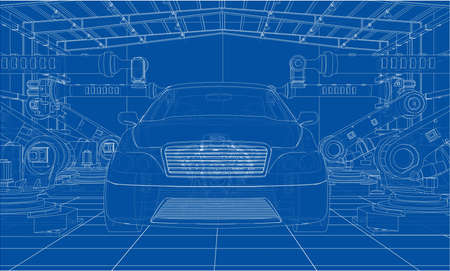1. Introduction to Wheel Alignment
Wheel alignment plays a crucial role in how a vehicle handles, how evenly the tires wear, and overall driving performance. It refers to the precise adjustment of suspension components to ensure the wheels are positioned correctly relative to the road and each other. Without proper alignment, a car may pull to one side, the steering may feel off, and tires may wear unevenly, leading to costly replacements.
Why Wheel Alignment Matters
Wheel alignment affects three major aspects of a vehicle:
- Performance: Proper alignment improves a car’s stability, responsiveness, and fuel efficiency.
- Handling: A well-aligned car drives straight, reduces steering effort, and enhances overall control.
- Tire Wear: Misalignment causes uneven tire wear, shortening tire lifespan and increasing maintenance costs.
Key Alignment Angles
There are three primary angles that define wheel alignment: camber, caster, and toe. Each of these angles ensures that the wheels interact with the road surface optimally.
| Alignment Angle | Definition | Effect on Vehicle |
|---|---|---|
| Camber | The angle of the wheel relative to the vertical axis when viewed from the front. | Affects cornering grip and tire wear. |
| Caster | The angle of the steering axis when viewed from the side. | Influences stability, steering feel, and returnability. |
| Toe | The direction the wheels point relative to each other when viewed from above. | Impacts straight-line stability and tire wear. |
Signs of Misalignment
Knowing when your vehicle is out of alignment can save you from excessive repair costs. Here are common signs:
- Vehicle pulls to one side when driving straight.
- Uneven or rapid tire wear.
- Steering feels off-center even when driving straight.
- Steering wheel vibrates at certain speeds.
How Alignment is Adjusted
Professional technicians adjust wheel alignment using specialized equipment to measure and correct these angles. Adjustments typically involve modifying tie rods, control arms, or struts to bring the wheels back into proper alignment according to manufacturer specifications.
Understanding wheel alignment not only enhances driving comfort but also maximizes the lifespan of your tires and ensures top-notch vehicle performance.
2. Understanding Camber
Camber refers to the tilt of the wheels when viewed from the front of the vehicle. It is measured in degrees and can be either positive, negative, or neutral. Proper camber settings are crucial for maintaining optimal tire contact with the road and affecting handling characteristics.
Camber Angle and Its Effects
Camber angle influences how the tire makes contact with the road surface. Here’s a breakdown of the different camber types:
| Camber Type | Description | Effect on Performance |
|---|---|---|
| Neutral Camber | The wheel is perfectly perpendicular to the road. | Even tire wear and straight-line stability. |
| Negative Camber | The top of the tire tilts inward toward the vehicle. | Improves cornering grip but may cause uneven tire wear. |
| Positive Camber | The top of the tire tilts outward away from the vehicle. | Rarely used in performance driving; helps off-road vehicles. |
Impact of Camber on Handling
Negative camber is commonly used in sports cars and performance applications because it helps maximize the tire’s contact patch during cornering. When a car turns, the outside tires bear most of the load, and negative camber keeps more of the tire in contact with the road surface, enhancing grip.
Camber and Tire Wear
While negative camber can improve cornering performance, excessive negative camber can lead to uneven tire wear. The inner edges of the tires may wear out faster than the outer edges, reducing tire lifespan.
Finding the Right Camber Angle
The ideal camber setting depends on the type of driving you do:
- Street Driving: A small amount of negative camber (-0.5 to -1.5 degrees) helps maintain good cornering grip without excessive tire wear.
- Track Use: More aggressive negative camber (-2 to -3 degrees) enhances grip but increases inner tire wear.
- Off-Road: Positive camber may be used in off-road vehicles to assist with heavy loads and rough terrain.
Setting the correct camber requires balancing grip with tire longevity. For performance applications, it’s essential to fine-tune camber alongside other alignment settings to maximize handling without sacrificing too much tire life.

3. The Role of Caster
Caster is one of the three key wheel alignment angles, alongside camber and toe. It refers to the angle of the steering axis when viewed from the side of the vehicle. Understanding caster and its effects is crucial for achieving a well-balanced and stable ride.
What Is Caster Angle?
The caster angle is the tilt of the steering axis, either forward or backward. It is measured in degrees and can be classified into two types:
| Type | Description | Effect |
|---|---|---|
| Positive Caster | Steering axis tilts towards the driver | Improves straight-line stability and steering returnability |
| Negative Caster | Steering axis tilts toward the front of the vehicle | Provides easier steering but reduces high-speed stability |
How Caster Affects Steering Stability
Positive caster is commonly used in performance and high-speed vehicles because it enhances stability. When the front wheels are rolling, the positive caster helps them return to the straight-ahead position after turning, reducing the need for constant steering corrections.
Caster and Steering Returnability
One of the most noticeable benefits of caster angle is steering returnability, which refers to how well the wheel returns to center after making a turn. A higher positive caster angle results in stronger self-centering force, making the car more predictable and easier to control.
Impact on High-Speed Control
High-speed driving demands precise control, and caster plays a crucial role in maintaining that control. A well-adjusted positive caster improves straight-line stability, reducing steering effort at highway speeds. This is why sports cars and race cars often have aggressive positive caster settings.
Finding the Right Balance
While a higher caster angle improves stability and returnability, too much positive caster can make low-speed steering heavier, especially in vehicles without power steering. Finding the right balance is key to maintaining both maneuverability and road stability.
4. Toe and Its Effects
What Is Toe Alignment?
Toe refers to the angle at which the wheels point relative to the centerline of the vehicle when viewed from above. It is measured in degrees and can be classified into two types:
| Type | Description |
|---|---|
| Toe-In | Front edges of the tires point toward each other. |
| Toe-Out | Front edges of the tires point away from each other. |
How Toe Affects Tire Wear
Improper toe alignment can cause excessive tire wear. When the toe setting is incorrect, the tires experience scrubbing, leading to accelerated wear on the tread.
- Excessive Toe-In: Causes wear on the outer edges of the tires.
- Excessive Toe-Out: Causes wear on the inner edges of the tires.
Impact on Straight-Line Stability
Toe alignment directly influences how a car tracks on the road. If the wheels are not set correctly, the vehicle may feel unstable or require constant small steering corrections.
- Toe-In: Improves straight-line stability but can reduce responsiveness in turns.
- Toe-Out: Increases cornering agility but may make the car feel twitchy on highways.
Adjusting Toe for Performance
Toe settings can be adjusted based on driving style and performance needs:
| Driving Style | Recommended Toe Setting |
|---|---|
| Daily Driving | Neutral or slight toe-in for stability and even tire wear. |
| Track and Performance Driving | Toe-out on the front for quicker turn-in response. |
| Drag Racing | Zero toe for minimum rolling resistance. |
Final Thoughts on Toe Alignment
Properly setting toe alignment enhances both tire longevity and vehicle handling. Whether you are looking for daily comfort or maximum performance, understanding toe adjustments helps achieve the desired driving characteristics.
5. Finding the Right Alignment for Performance
Choosing the right alignment settings depends on your driving habits and performance needs. Whether you’re commuting daily, enjoying spirited driving, or hitting the track, your camber, caster, and toe settings should match your goals.
Understanding Alignment Settings for Different Driving Styles
Each driving scenario requires different alignment setups. Here’s a simple breakdown:
| Driving Style | Camber | Caster | Toe |
|---|---|---|---|
| Daily Driving | Neutral to Slight Negative | Positive | Neutral to Slight Toe-In |
| Spirited Driving | More Negative | Increased Positive | Neutral |
| Track Performance | High Negative | Maximum Positive | Slight Toe-Out |
Daily Driving: Comfort and Tire Longevity
If you mostly drive on regular roads, your alignment should focus on even tire wear and stability. A neutral camber, positive caster, and slight toe-in help maintain comfort and reduce excessive tire wear.
Spirited Driving: Balance Between Grip and Wear
For those who enjoy twisty roads, adding more negative camber can enhance cornering grip. A slightly increased caster angle also improves steering feel, while a neutral toe setting keeps responsiveness in check.
Track Performance: Maximizing Handling
On the track, precision is everything. A high negative camber ensures optimal tire contact in corners, while a maximum positive caster aids high-speed stability. A slight toe-out improves turn-in response but can cause tire wear on straight roads.
Final Considerations
Adjusting alignment for performance is about finding the right balance. If your car serves multiple purposes, a compromise setup may be the best choice. Always check alignment regularly to maintain optimal performance and tire life.


